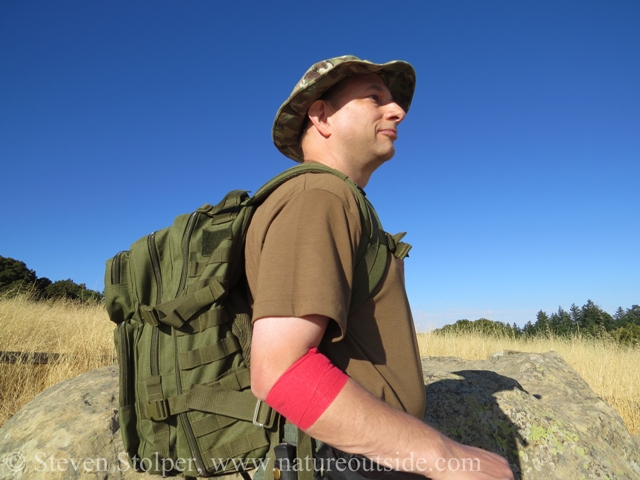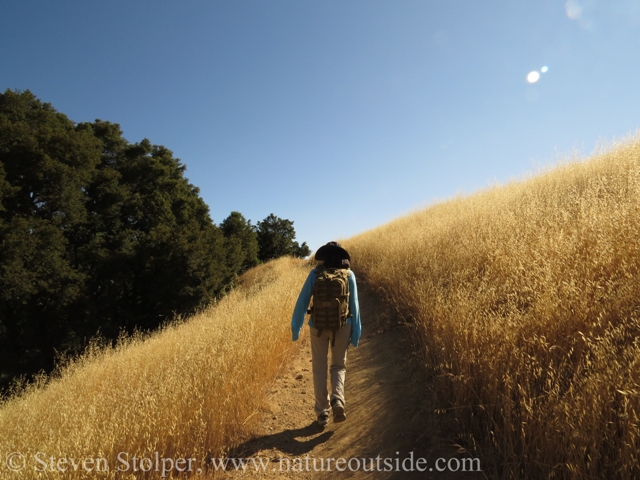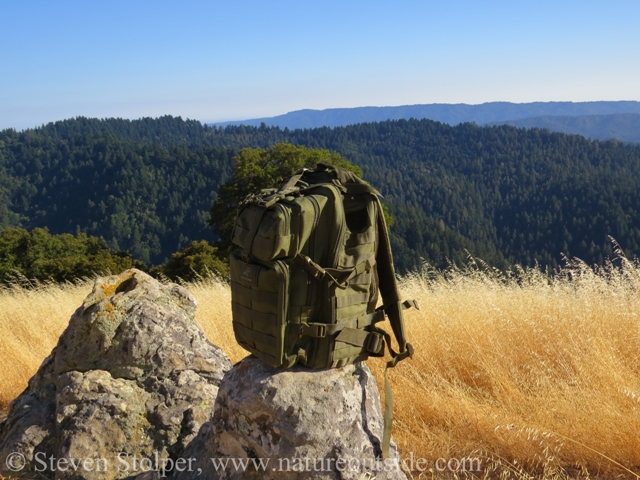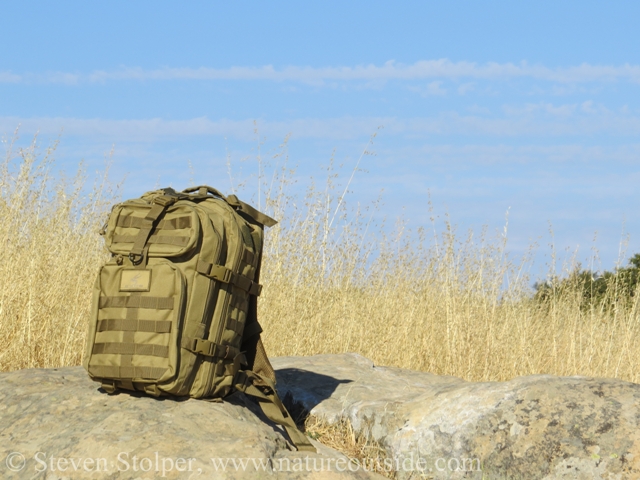
When the weather’s hot, you need to stay cool.
Most of the United States is in the midst of a summer heat wave. These broiling temperatures are no joke!
When you’re out on the trail, it’s very important to prevent heat-related injury. Hiking in hot weather can be tricky. Heat related problems can sneak up on you if you’re unprepared. So here are 16 tips to keep you cool on the trail.
1. Hike early in the morning
Cheat the heat! Start your hike in the early morning hours. Heat begins to build late morning and peaks by 3:00 pm. If you can get your miles in early, you can avoid the heat of the day.
Morning is preferable to hiking late in the day. You have plenty of daylight in case you hike slower than you anticipate or become lost. Your chances of viewing wildlife are greater in the early morning hours when wildlife is active.
Many times during summer I arrange to be at the trailhead just as the sun is rising.
2. Select a shaded hike
Choose a hike that’s under cover of forest or at the bottom of a shaded canyon. This is another way to cheat the heat. The shade is cooler and you can find water features in this terrain. Climb the barren treeless mountain another day.
3. Freeze your water bottle
This is one of my favorite tricks. The night before a hot weather hike, I fill my water bottle no more than half way. Then I put it in the freezer overnight. In the morning, I top it off with water and head out on the trail. The water remains ice cold through much of the day.
Do not fill your bottle more than half way before you put it in the freezer! As water cools, its molecules arrange themselves in an orderly fashion. This takes up more room than the water. So water expands when it freezes. If you fill your water bottle too much, the ice will crack the sides of the bottle! So leave space for the water to expand vertically.
Since the ice takes more room than liquid water, you will carry slightly less water in your bottle. But I prefer the cold water and am willing to sacrifice some additional fluid.
Unlike in a tent, do not turn your bottle upside-down before putting it in the freezer. All the water in your bottle will freeze. So it is better to leave airspace at the top of the bottle where you can add liquid the following morning.
God, it was hot! Forget about frying an egg on the sidewalk; this kind of heat would fry an egg inside the chicken.
― Rachel Caine
4. Pack an extra shirt
If you plan to sleep out overnight, pack an extra shirt. When you reach camp, change out of your sweaty shirt and into a dry one. This is important in environments where the days are hot and temperatures plunge at night. An example is at high altitudes in the mountains. You don’t want to get chills from wearing a sweaty shirt.
5. Use sunscreen
You shouldn’t need a song to remind you to wear sunscreen. Protecting your skin from UV damage is always a good idea. But it also helps you stay hydrated. Burns damage blood vessels and cause fluid loss. Sunburns are a type of burn. Use sunscreen to protect your valuable hide and decrease fluid loss from burned skin.
6. Dip your bandana
My bandana is a multi-use item that comes in handy on hot days. When I pass a flowing stream or large lake, I wet my bandana and tie it around my neck. The water conducts heat away from my skin as it warms and evaporates. It’s a refreshing pick-me-up on the trail.
I never dip my bandana into stagnant or dank water. I keep an eye out for sources of pollution and avoid wrapping the bandana around my head. I don’t want water dripping into my eyes that may contain pollutants or unfriendly microorganisms.

Covering exposed skin will help reduce fluid loss
7. Rest in the shade
I’m shocked how often I call a halt and the group just stands there in full sun. Find a tree, a boulder, an overhang, even a large stump. But find some shade! Seek every opportunity to get out of the heat when you can.
8. Stay hydrated
Men need more than 3 liters of water each day during normal conditions. Women require slightly less.
Drink plenty of fluids even if you do not feel thirsty. The body’s thirst mechanism lags its need for water. By the time most of us feel thirst, we are already 2% dehydrated (2% of total body weight has been lost). Avoid drinks with caffeine or alcohol, as they can contribute to dehydration.
9. Eat small meals and eat more often
I first heard this tip from the American Red Cross. They recommend eating smaller meals more often in hot weather. I tend to follow this practice. But I cannot find the scientific justification for doing so. The rationale for eating small meals seems to be that eating a large meal can increase metabolic (internal body) heat as the the body digests and metabolizes the food. Eating more often is to keep energy levels high when oppressed by hot weather.

It’s hot on the ridge!
10. Avoid extreme temperature changes
This is another tip from the American Red Cross. Sudden temperature changes (i.e. going from an oppressively hot environment into air conditioning) places stress on the body. This can cause some minor problems (dry skin, dry mucus membrane and eyes, eye infections, respiratory infections and muscular spasms) and exacerbate more serious chronic conditions. Cool down gradually.
11. Cover up
Wear loose-fitting, lightweight, light-colored clothing. Make sure your clothes are breathable. I wear moisture-wicking clothes for comfort. Avoid dark colors because they absorb the sun’s rays. It may seem counter-intuitive, but covering exposed skin helps to keep you cool and slows fluid loss.
12. Slow down and try to avoid strenuous exercise during the hottest part of the day
This tip is on everybody’s list. Try not to overexert yourself during the hottest parts of the day. Slow your pace to manage your energy and reduce fluid loss.

Find shade where you can
13. Use a buddy system when hiking in excessive heat
This is a variation of a tip from the American Red Cross. If you hike in pairs, each can check the other for signs of heat-related problems. Remember, as you dehydrate your mental functions decline. Your faculties can desert you before you realize you’re in serious trouble. That’s where your buddy comes in!
14. Take frequent breaks
Pace yourself to prevent overexertion. Use these breaks to hydrate. Enough said.
15. Wear a hat with a wide brim
Wear a hat with a wide brim. It protects your face, eyes, ears, and the back of your neck from the sun. You’ll be surprised how much better you feel wearing a hat with a wide brim instead of a baseball cap.
16. Wear sunglasses
Have you had a splitting headache after a hot day’s hike? Besides the long-term benefits for your eyes, sunglasses can save you from headaches caused by glare. You may not be any more or less hydrated, but you’ll feel a whole lot better!
Of all the tips in this article, wearing sunglasses is the one I need to work on!
Tell me your tips for hiking in hot weather
Do you have a favorite trick to keep you cool while hiking? Tell me about it in the comments section below.
Related Articles on NatureOutside
Wilderness First Aid and the Duty of Care to Yourself
My most popular first aid supply of the year!
Hypothermia Claims another Hiker
For fun facts and useful tips, join the free Bushcraft Newsletter.



Great post – I used number 3 (frozen bottles) when I went for a 20 mile walk in the high 70s on Friday – it worked a treat.
Chris, I’m glad the frozen bottle trick worked for you. Twenty miles is some walk! Hike on!
When wearing long sleeves to protect skin from the sun, you can also wet your sleeves same as bandana. Wrists have large blood vains and wet sleeves cool you down.
Thanks for the tip, Vilzu!
I would only recommend this as a last resort, but once I was out in July hiking through Yosemite and it was well into the 90s. The trail I was on was white stone and had very little shade, so I was catching the heat from above and from the reflection off the stone below.
There were also thousands of insects – gnats, flies, horseflies, etc. – making my life miserable.
I had forgotten to pack sunscreen, so to improvise, I rubbed loose dirt all over my exposed skin. I don’t know how well it protected me, because I was already pretty sunburnt by this time, but as soon as I applied it, I felt some relief – my skin felt cooler and I could feel my body temperature regulating. As a secondary benefit, it absorbed most of my sweat and kept the flies at bay. Plus, I looked like I’d been out on the trail for months, which gave me instant “trail cred” to passers-by. 🙂
Steve, thanks for the great story! I think the mud was worth it just for the “trail cred!”
In an emergency, mud can be used as sunscreen. Another option, in Yosemite, is to use the white powder found on the outer bark of Aspen trees. It has been used traditionally as a sunscreen.
Wow, awesome bit of useful info. Thanks for sharing!
I recently ran out of water on a hike on a hot day, so purchased a bigger water bottle. Also by 10AM might as well taken a flask of coffee as it was hot. So will try out your freezer tip next hike. My new water bottle is white rather than black I am assuming this will help reflect the heat rather than absorb it.
All of that sounds great. If you try the frozen water bottle trick, remember to keep the water level low when you put it in the freezer. This gives the ice a place to expand so it doesn’t crack the bottle. Let me know how it turns out!
In the SW high desert of Utah/NM of a July heat wave I resorted to dipping my large, thin cotton scarf and hat in cold water and draping the scarf around me. It provided coolness to sustain me through some relatively short hikes of 2 to 3 miles.
That’s a good tip Rita. It helps the evaporative cooling of your body and it feels great!
I dip my bandanna in water and freeze it the night before so by the time I pull it out during my hike to wrap around my neck the bandanna has thawed out but it’s still very chilly.
Very cool, Michelle! 🙂
I use a sun umbrella hiking in the Arizona desert… cools me down without having a hat on, which makes me hotter. Life changer for year round AZ hiking.
Pat, this is an interesting idea. Thanks for sharing your experience.
I’ve seen a number of advertisements lately for “hiking umbrellas.” I wonder if they are going to become trendy. While an umbrella is inconvenient in high winds, I can see how they would be wonderful in the desert.
I’ve gotten so efficient at attaching my sun umbrella that I can partially collapse as necessary passing through brush that impedes my passage and this also assists when winds get gusty… if just a steady breeze there is little impact on using the umbrella. I can also take my pack off and put it back on now without having to remove the open umbrella.
I always hike in cooler weather..few months back I joined a trail group that hike year round. They hike on weekends and every other week they do an evening hike that’s about 3 to 4 hours one day during the week. Yesterday was so warm and even though we had complete shade, there was no wind. I was hot and thought I was going to pass out or throw up. Thank fully 2 other people in the group were willing to break from the group to head back. I told one of the group leaders after that I may not be doing anymore. I enjoy the group a lot..and don’t want to miss out. Sp these will definitely help. Im also going to see if I can find lighter pants then the ones I have. Definitely the frozen water and going to get a cool towel. I’ve used them in the part for outdoors activities.
Brandie, I’m glad you are alright. I think you made a smart decision to turn back when you knew you weren’t feeling right.
Hopefully, you can use some of these strategies to keep cooler when you hike. Your body may also acclimate if you spend more time in warmer weather. But don’t overdo it or overexert yourself. Take smaller hikes until you feel more comfortable hiking in warm weather.
I hope you find a way to prepare for heat and hike when it’s hot out. Go slowly and experiment with different ways to beat the heat.
An old-fashioned light straw hat with a wide brim does not heat your head and keeps the sun off nicely. The pioneers were on to something!
Mariska, it’s amazing how many of the “old” solutions are still the best, even with our modern materials. This is a great example of that.